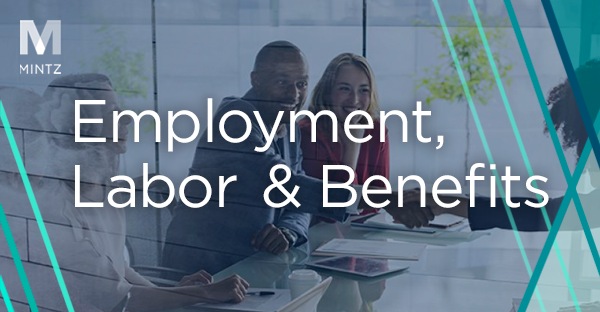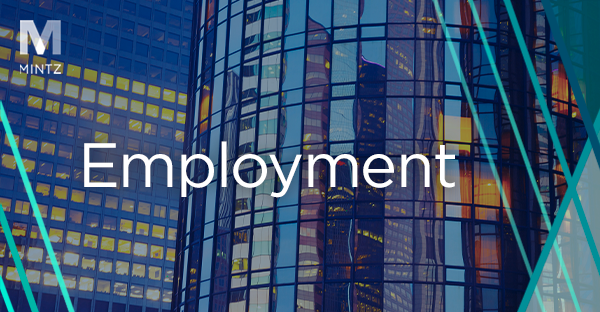Artificial Intelligence Executive Order: Workplace Implications
President Trump’s executive order entitled Removing Barriers to American Leadership in Artificial Intelligence (the “Trump AI Order”) seeks to create “a path for the United States to act decisively to retain global leadership in artificial intelligence.” The Trump AI Order purports to “revoke[] certain existing AI policies and directives that act as barriers to AI innovation,” although it does not shed light on any specific policies and directives that are revoked by virtue of the order. The Trump AI Order also comes in the wake of President Trump’s earlier Executive Order revoking several Biden-era orders, most notably including President Biden’s Executive Order on the Safe, Secure, and Trustworthy Development and Use of Artificial Intelligence (the “Biden AI Order”), which had directed federal agencies to undertake various initiatives and studies regarding the uses, benefits, and potential pitfalls of AI. While the Trump AI Order broadly impacts AI-policy on multiple levels, this advisory focuses on its impact on the U.S. workforce.
What Does the Trump AI Order Say?
In some ways, the Trump AI Order marks a return to AI policy from President Trump’s first term. In 2019, then-President Trump issued an executive order entitled Accelerating America’s Leadership in Artificial Intelligence (the “2019 Trump AI Order”), which, among other things, launched the American AI Initiative to increase AI-related research and development efforts through public-private partnerships, set forth technical standards related to AI, and called for the prioritization of fellowships and training programs to help U.S. workers gain AI-relevant skills. Many of these 2019 Trump AI Order initiatives were then codified into law with the passage of the National Artificial Intelligence Initiative Act in 2020 and the establishment of the National Artificial Intelligence Initiative Office in 2021. Then, in 2023, the Biden Administration issued the Biden AI Order, which outlined the Biden Administration’s efforts to tackle the perceived lack of AI regulation and to “ensure that AI complies with all Federal laws and to promote robust technical evaluations, careful oversight, engagement with affected communities, and rigorous regulation.” The Biden AI Order included commitments to advance policies and federal agency regulations that: (i) protected individuals from employment and housing discrimination due to potential AI bias issues; (ii) promoted equal opportunity and anti-discrimination law compliance via increased regulation of AI; and (iii) secured various other consumer and civil liberty protections.
President Trump has now rescinded the Biden AI Order, seeking to redirect the U.S. approach to regulation of artificial intelligence. Specifically, the Trump AI Order calls for the immediate suspension and ultimate revocation of any federal agency policies, directives, regulations, orders, or other actions that were issued pursuant to the Biden AI Order and seeks to advance AI innovation “by the strength of free markets, world-class research institutions, and entrepreneurial spirit.” It further aims to position the U.S. as a global AI leader, to promote national security interests related to AI, and to do so by ensuring that the development of AI systems is “free from ideological bias or engineered social agendas.” In this way, the Trump AI Order resembles other recently issued Trump Administration executive orders that have attempted to curb diversity, equity, and inclusion efforts across various public and private spaces (we have written about some of those efforts here). Administratively, the Trump AI Order directs various administration officials and the heads of executive departments and agencies to develop an “AI action plan” within 180 days (by mid-July) to remove any AI-related regulations that may impede the advancement of AI development.
The Trump AI Order’s Impact on Other Federal Guidance.
The nascent Trump AI Order will have a significant impact on the workplace, and some developments are already visible. Within days of the Trump AI Order’s issuance, the U.S. Equal Employment Opportunity Commission (EEOC) removed from its website various guidance documents related to the intersection of AI and federal anti-discrimination laws. In 2023, the EEOC had issued technical assistance guidance that cautioned employers to use AI workplace tools responsibly, addressed the use of AI software and algorithms in employment selection processes under Title VII and employers’ various compliance responsibilities related to the accommodation and treatment of individuals with disabilities under the Americans with Disabilities Act. While the Trump AI Order did not expressly rescind these guidance documents, it appears that the EEOC (as a result of the Trump AI Order) may de-emphasize some of the AI-related regulatory/enforcement initiatives that were established during the Biden Administration. Likewise, guidance issued by the Office of Federal Contract Compliance (OFCCP) entitled “Artificial Intelligence and Equal Employment Opportunity for Federal Contractors,” which addressed federal contractors’ compliance obligations with the use of AI, also appears to have disappeared from the federal agency website.
However, not all guidance has vanished. In 2024, the Department of Labor (DOL) issued a document entitled “Artificial Intelligence and Worker Well-Being – Principles and Best Practices for Developers and Employers,” which recommended that employers include workers in the AI adoption process, bargain with unions in good faith regarding the adoption of AI technologies, establish AI governance and human oversight, not rely on AI systems in making “significant employment decisions” free from “meaningful human oversight,” and monitor AI to safeguard worker rights, including with respect to leaves of absence, accommodations, wages, and break times. The DOL guidance remains available, at least for now, and has not been impacted by the Trump AI Order (although a statement on the press release page for these best practices states “As of 01/20/2025, information in some news releases may be out of date or not reflect current policies”). However, the other guidance we discussed earlier has disappeared and, at least as of this writing, nothing has taken its place.
The Trump AI Order Does Not “Trump” Existing Federal and State Laws.
While federal regulatory and other guidance on the use of AI in the workplace appears to have been voided (or, at the very least, removed from agency websites), the Trump AI Order does not suspend applicable federal, state, or local laws, which employers must still account for when using AI.
First and foremost are federal anti-discrimination laws. While the Trump AI Order may seek to deprioritize the federal government’s focus on ensuring that AI is not used to perpetuate or generate discriminatory biases in employment decisions, it does not supersede or otherwise abridge federal law. It goes without saying that businesses cannot discriminate against individuals on the basis of membership in any protected class. This, of course, extends to the use of AI tools by employers to assist in hiring or other employment processes. Indeed, while the guidance documents from the EEOC referenced above have disappeared from the EEOC’s website, many of the recommendations contained in them were derived from federal laws and could still help guide best practices. For example, the EEOC’s guidance document (which we wrote about here), recommended that employers ensure that AI tools do not “screen out” potential candidates who might have a disability, or inadvertently make disability-related inquiries on job applications – which generally would still violate the law notwithstanding the Trump Administration’s apparent move away from the earlier guidance.
Second, the growing mosaic of state and local laws regulating AI remain intact following the Trump AI Order and are worth revisiting. Foremost among these laws is New York City Local Law 144 (which we previously wrote about here and here). As New York City employers will recall, Local Law 144 represents a first-of-its-kind law that regulates the use of automated employment decision tools, known as “AEDTs” in the workplace. NYC’s broad law requires employers to take several affirmative steps before using AEDTs in employment decisions, including most notably: (i) subjecting AEDTs to a “bias audit” within one year of its use; (ii) ensuring that the results of such audits are publicly available; (iii) providing particular notices to job candidates regarding the employer’s use of these tools; and (iv) allowing candidates or employees to request alternative evaluation processes as an accommodation in certain circumstances. In addition, New York’s Governor has announced that she will direct the New York Department of Labor to amend the New York Worker Adjustment and Retraining Notification Act (“WARN”) regulations to require that NY WARN notices address whether layoffs are related to the employer’s use of AI, and a bill is currently pending to expand NY WARN requirements.
But New York is not alone in its attempt at regulating AI in employment. Colorado recently passed the Colorado Artificial Intelligence Act (“CAIA”), which goes into effect on February 1, 2026. The CAIA is broader in scope than Local Law 144 and represents the first truly comprehensive AI legislation seen in the US. The CAIA broadly regulates the use of AI in not only the employment context, but in the financial services, housing, health care, education, insurance and legal services contexts. Designed to protect against “algorithmic discrimination,” the CAIA places obligations on “deployers” of AI tools (i.e., employers) and “developers.” Like Local Law 144, “deployers” of AI tools must conduct an “impact assessment” when using AI systems, which must include, among other information, a statement describing the purpose and intended use of the tool, an analysis of foreseeable risks of algorithmic discrimination, and a description of input and output data. Leading up to the effective date, Colorado employers should certainly conduct a comprehensive review of all AI systems they use to prepare to comply with the CAIA.
Beyond New York and Colorado, California has also stepped into the AI-regulation fray. On November 8, 2024, the California Privacy Protection Agency voted to proceed with formal rulemaking regarding “automated decision-making technology.” Virtually identical to the “AEDTs” regulated in New York City, the California draft legislation regulating these tools would also place many similar requirements on employers to those seen in New York City. Included among these are “pre-use notice,” which would require employers to provide candidates with notice of the use of an AI-tool in employment decision processes, conduct bias reviews, and allow candidates to opt-out of the use of such tools for significant employment decisions. The California regulations remain in draft form, but certainly forecast future regulation not dissimilar from that seen in New York City.
Other Considerations for Employers Going Forward.
While employers must understand the legal landscape and comply with existing laws, what else can they do in light of these evolving changes?
First, employers should aim to ensure their workforces are prepared for the ongoing AI revolution and monitor any federal initiatives which may provide a pathway (and funding) for programs aimed at AI-related workforce trainings and development initiatives. The 2019 Trump AI Order noted that it will be necessary to prepare the U.S. workforce with the skills needed to adapt and thrive in the new age of AI. The American AI Initiative called for agencies to prioritize fellowship and training programs to help American workers gain AI-relevant skills through apprenticeships, skills programs, fellowships, and education in computer science and other growing Science, Technology, Engineering, and Math (STEM) fields. The new Trump AI Order follows these initiatives and encourages workforces to obtain new skills to continue United States AI leadership. Future legislation may also be passed to address educational costs for students and seasoned workers who need to upskill and retool for future jobs.
Though there may be expanded federal programs and funding on the horizon to support employer-sponsored education, training, and upskilling programs, employers have some tools at their disposal already. For example, employers can implement qualified educational assistance plans, offer student loan debt repayment programs, design 401(k) and 403(b) plans to treat an employee’s student loan payments as elective deferrals for purposes of eligibility to receive employer matching contributions under the plan, and provide working condition fringe benefits to cover educational costs that maintain or improve required skills or meet a condition to maintain a particular job. Employers may also consider partnering with educational institutions to provide or partake in job-related training, internships, and research endeavors to prepare workers for future jobs.
Second, employers should consider designing worker assistance programs to prepare for future worker displacement. Workplace disruptions and displacements resulting from advancements in AI are of growing concern (and have been addressed by both the Biden and Trump Administrations). If an employer’s workforce is subject to disruption due to the proliferation of AI, employers may wish to proactively consider developing workplace transition policies, which could include provisions around severance pay plans, retirement window programs, career-transitioning services, and alternative work arrangements. In structuring these programs, employers must be aware of compliance obligations (including anti-discrimination laws) and should be mindful of the impact of these changes on the well-being of their workforce.
These are only a few of the considerations employers must navigate as the impact of AI in the workplace continues to unfold and as government guidance continues to shift. The Mintz Employment team is continuing to monitor ongoing announcements by the Trump Administration along with other judicial and legislative developments and stands ready to assist employers in responding to the rapidly evolving landscape.






